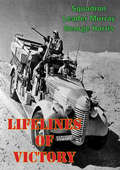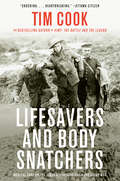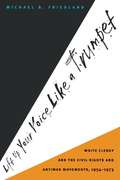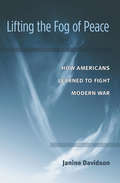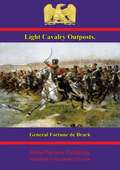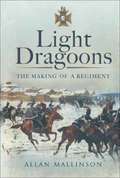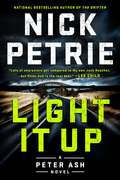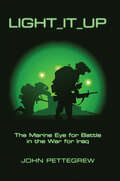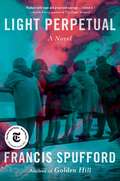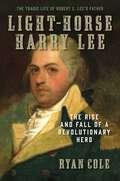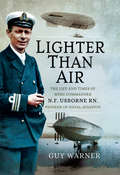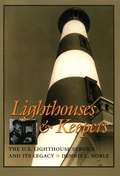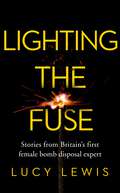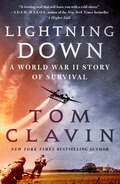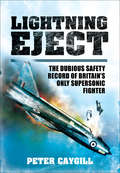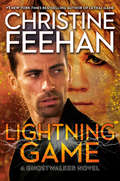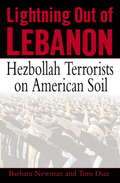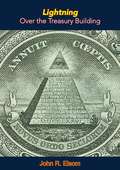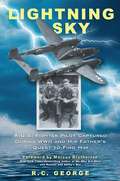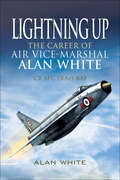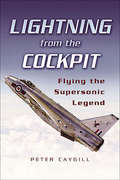- Table View
- List View
Lifelines Of Victory
by Squadron Leader Murray George Harris“Amateurs study tactics,” goes an old saying, “armchair generals study strategy, but professionals study logistics” and Squadron Leader Murray Harris heartily believed in it. In this book he surveys the early actions of the Second World War so as to demonstrate and prove his point, focusing on the transportation of troops, supplies, oil and ammunition he traces the emerging patterns that would dominate the entire period.
Lifesavers and Body Snatchers: Medical Care and the Struggle for Survival in the Great War
by Tim CookFrom Canada&’s top war historian, a definitive medical history of the Great War, illuminating how the carnage of modern battle gave birth to revolutionary life-saving innovations. It brings to light shocking revelations of the ways the brutality of combat and the necessity of agonizing battlefield decisions led to unimaginable strain for men and women of medicine who fought to save the lives of soldiers.Medical care in almost all armies, and especially in the Canadian medical services, was sophisticated and constantly evolving, with vastly more wounded soldiers saved than lost. Doctors and surgeons prevented disease from decimating armies, confronted ghastly wounds from chemical weapons, remade shattered bodies, and struggled to ease soldiers&’ battle-haunted minds. After the war, the hard lessons learned by doctors and nurses were brought back to Canada. A new Department of Health created guidelines in the aftermath of the 1918-19 flu pandemic, which had killed 55,000 Canadians and millions around the world. In a grim irony, the fight to improve civilian health was furthered by the most destructive war up to that point in human history. But medical advances were not the only thing brought back from Europe: Lifesavers and Body Snatchers exposes the disturbing story of the harvesting of human body parts in medical units behind the lines. Tim Cook has spent over a decade investigating the history of Canadian medical doctors removing the body parts of slain Canadian soldiers and transporting their brains, lungs, bones, and other organs to the Royal College of Surgeons (RCS) in London, England. Almost 800 individual body parts were removed from dead soldiers and sent to London, where they were stored, treated, and some presented in exhibition galleries. After being exhibited there, the body parts were displayed in Canada. This uncovered history is a shockingly revelation never told before and part of the hidden legacy of the medical war. Based on deep archival research and unpublished letters of soldiers and medical personnel, Lifesavers and Body Snatchers is a powerful narrative, told in Cook&’s literary style, which reveals how the medical services supported the soldiers at the front and forged a profound legacy in shaping Canadian public health in the decades that followed.
Lift Up Your Voice Like a Trumpet: White Clergy and the Civil Rights and Antiwar Movements, 1954-1973
by Michael FriedlandWhen the Supreme Court declared in 1954 that segregated schools were unconstitutional, the highest echelons of American religious organizations enthusiastically supported the ruling. Many white southern clergy, however, were outspoken in their defense.
Lifting the Fog of Peace: How Americans Learned to Fight Modern War
by Janine DavidsonHow military organizations trained for conventional war adapt—or fail to adapt—to nontraditional missions
Lifting the Silence: A World War II RCAF Bomber Pilot Reunites with his Past
by David Scott Smith Sydney Percival SmithAt a time of great sacrifice in Canadian history, we are welcomed into the homes, the hearts, and the minds of mothers, sons, fathers, and friends as we follow Syd Smith and his high-school brotherhood of 13 when they answer the call to duty in 1941. Written with his son, David, Lifting the Silence is also a father-and-son journey of discovery that uncovers a remarkable letter that serves as testament to what still defines Canada today. Postmarked "France August 1946," the fragile letter bares the soul of a people beaten down by cruel times and extols their admiration and gratitude for Canada as a nation of spiritual and economic resources that helped them out so much during the war. Within the letter as well, a heartfelt and strikingly prophetic expression of hope to once again receive the downed pilot they had sheltered in 1942. As if by Providence, this letter now serves to reunite Syd with his angel of the French Resistance 61 years later.
Light And Shade In War [Illustrated Edition]
by Noel Ross Captain Malcolm RossTwo Kiwis recount their experiences of the Front at Gallipoli and France during the First World War. Included are a number of their own photographs."THE authors of this book, father and son, have seen much of the Light and Shade of War during the past two years, the one as a War Correspondent in Egypt, Turkey and France, the other as a soldier, and, afterwards, as one of the staff of The Times."The day for writing the histories of our different campaigns is not yet. For the purposes of history delay is necessary, even though the gain in perspective may mean loss in colour. But there is a legitimate desire for the intimate and immediate impressions of the time, written down amid the ever-shifting scenes of the War itself. Such impressions will have some value now, and perhaps also in after years.Most of these sketches were written whilst the scenes and incidents they depict were fresh in the mind; some under fire. The proofs were corrected on the battlefield of the Somme in a tent over which British and German shells were passing at the time. While due allowance will be made for shortcomings owing to the circumstances under which the book was produced, the authors hope that no apology will be needed for presenting such pictures of the Light and Shade of War to the English-speaking World."
Light Cavalry Outposts
by General Fortune de Brack Colonel L A Hale R. E. HaleGeneral De Brack served Napoleon and France for many years as a light cavalryman during the wars that raged for over a decade. He served under some of the most able and dashing of officers, including the legendary Lasalle and the celebrated Pajol. During this time, the skills and instincts of outpost duty were engraved on his mind, time-taught instincts long forgotten by the army in peace time. In his older age he was approached by the officers of his regiment to recount his advice, lessons and memoirs so that the invaluable experience could be passed on. In his book, Light Cavalry Outposts, General De Brack dispenses his maxims for service in the light cavalry interspersed with memories of his service under the eagles of Napoleon. Author -- General Fortune de Brack (1794-1854)Translator -- Colonel L A Hale, R.E. (d. 10.1914)Text taken, whole and complete, from the fourth edition published in London, W. Mitchell and Co, 1876.Original Page Count - xxii, 308 p.Illustrations -- 3 maps and plans.
Light Dragoons: The Making of a Regiment
by Allan MallinsonAlthough only formed in December 1992, The Light Dragoons look back to a history that began in the days of the first Jacobite rebellion. In 1922 a reduction in the Armys strength saw the amalgamation of four regiments of Hussars into the 13th/18th Hussars and the 15th/19th Hussars. Now they too have been amalgamated, with a name that reverts to the titles of the four original regiments in the eighteenth century. Allan Mallinson, the novelist and a former commanding officer of the 13th/18th Hussars, not only follows with admirable clarity and dexterity the fortunes of The Light Dragoons predecessors in this new edition, but describes the activities of the new regiment up to the minute. It is a crowded canvas which reflects much of the last two hundred and seventy years of British history. No campaign of significance has been fought in that time without the participation of one or more of the Regiments. Three, for instance, fought in the Peninsula, one in the Crimea and three in South Africa.In the twentieth century they gained fresh honours in both World Wars and, since 1945, have been fully involved in Britains withdrawal from Empire, the Cold War, United Nations peacekeeping and Iraq and Afghanistan.The new Postscript gives the reader a fine account of what wars in Bosnia and Iraq have involved for the Regiment and the men who serve in it and this updated history is a superb snapshot of life in war and peace for a British armoured reconnaissance regiment. Light Dragoons takes its place among the classics of this genre such as Sir Arthur Bryants Jackets of Green and Rudyard Kiplings account of the Irish Guards in the Great War.
Light Horse
by Jean BouThe mounted soldier is one of the most evocative symbols in Australian military history. Now a celebrated part of Australia's army heritage, the role and very existence of mounted troops in modern warfare was being called into question at the time of its most crowning military moments. Light horse regiments, particularly those that served in South Africa, Palestine and the trenches of Gallipoli, played a vital role in Australia's early military campaigns. Based on extensive research from both Australia and Britain, this 2009 book is a comprehensive history of the Australian Light Horse in war and peace. Historian Jean Bou examines the place of the light horse in Australia's military history throughout its existence, from its antecedents in the middle of the nineteenth century, until the last regiment was disbanded in 1944.
Light It Up (A\peter Ash Novel Ser. #3)
by Nick PetrieIn this action-packed thriller starring war veteran Peter Ash, a well-planned and flawlessly executed hijacking reveals the hidden dangers of Colorado's mellowest business, but Ash may find there’s more to this crime than meets the eye. Combat veteran Peter Ash leaves a simple life rebuilding hiking trails in Oregon to help his good friend Henry Nygaard, whose daughter runs a Denver security company that protects cash-rich cannabis entrepreneurs from modern-day highwaymen. Henry’s son-in-law and the company’s operations manager were carrying a large sum of client money when their vehicle vanished without a trace, leaving Henry’s daughter and her company vulnerable. When Peter is riding shotgun on another cash run, the cargo he’s guarding comes under attack and he narrowly escapes with his life. As the assaults escalate, Peter has to wonder: for criminals this sophisticated, is it really just about the cash? After finding himself on the defensive for too long, Peter marshals his resources and begins to dig for the truth in a scheme that is bigger—and far more lucrative—than he’d ever anticipated. With so much on the line, his enemy will not give up quietly...and now he has Peter directly in his sights.
Light It Up: The Marine Eye for Battle in the War for Iraq
by John PettegrewExamines the U.S. Marines’ visual culture of combat in the Iraq War.American military power in the War on Terror has increasingly depended on the capacity to see the enemy. The act of seeing—enhanced by electronic and digital technologies—has separated shooter from target, eliminating risk of bodily harm to the remote warrior, while YouTube videos eroticize pulling the trigger and video games blur the line between simulated play and fighting.Light It Up examines the visual culture of the early twenty-first century military. Focusing on the Marine Corps, which played a critical part in the invasion and occupation of Iraq, John Pettegrew argues that U.S. military force in the Iraq War was projected through an "optics of combat." Powerful military technology developed in the Iraq and Afghanistan wars has placed war in a new posthuman era.Pettegrew’s interviews with marines, as well as his analysis of first-person shooter videogames and combat footage, lead to startling insights into the militarization of popular digital culture. An essential study for readers interested in modern warfare, policy makers, and historians of technology, war, and visual and military culture.
Light Perpetual: A Novel
by Francis SpuffordFrom the critically acclaimed and award‑winning author of Golden Hill, a mesmerizing and boldly inventive novel tracing the infinite possibilities of five lives in the bustling neighborhoods of 20th-century London.Lunchtime on a Saturday, 1944: the Woolworths on Bexford High Street in southeast London receives a delivery of aluminum saucepans. A crowd gathers to see the first new metal in ages—after all, everything&’s been melted down for the war effort. An instant later, the crowd is gone; incinerated. Among the shoppers were five young children. Who were they? What futures did they lose? This brilliantly constructed novel lets an alternative reel of time run, imagining the life arcs of these five souls as they live through the extraordinary, unimaginable changes of the bustling immensity of twentieth-century London. Their intimate everyday dramas, as sons and daughters, spouses, parents, grandparents; as the separated, the remarried, the bereaved. Through decades of social, sexual, and technological transformation, as bus conductors and landlords, as swindlers and teachers, patients and inmates. Days of personal triumphs, disasters; of second chances and redemption. Ingenious and profound, full of warmth and beauty, Light Perpetual illuminates the shapes of experience, the extraordinariness of the ordinary, the mysteries of memory and expectation, and the preciousness of life.
Light-Horse Harry Lee: The Rise and Fall of a Revolutionary Hero - The Tragic Life of Robert E. Lee's Father
by Ryan Cole"Light-Horse Harry blazes across the pages of Ryan Cole's narrative like a meteor—and his final crash is as destructive. Cole tells his story with care, sympathy, and where necessary, sternness. This book is a great, and sometimes harrowing read." —Richard Brookhiser, senior editor at National Review and author of Founding Father: Rediscovering George Washington Who was "Light-Horse Harry" Lee? Gallant Revolutionary War hero. Quintessential Virginia cavalryman. George Washington’s trusted subordinate and immortal eulogist. Robert E. Lee’s beloved father. Founding father who shepherded the Constitution through the Virginia Ratifying Convention. But Light-Horse Harry Lee was also a con man. A beachcomber. Imprisoned for debt. Caught up in sordid squabbles over squalid land deals. Maimed for life by an angry political mob. Light-Horse Harry Lee’s life was tragic, glorious, and dramatic, but perhaps because of its sad, ignominious conclusion historians have rarely given him his due—until now. Now historian Ryan Cole presents this soldier and statesman of the founding generation with all the vim and vigor that typified Lee himself. Scouring hundreds of contemporary documents and reading his way into Lee’s life, political philosophy, and character, Cole gives us the most intimate picture to date of this greatly awed but hugely talented man whose influence has reverberated from the founding of the United States to the present day.
Lighter Than Air: The Life and Times of Wing Commander N.F. Usborne RN, Pioneer of Naval Aviation
by Guy WarnerNeville Florian Usborne entered the Royal Navy as a cadet in 1897. In the years between him joining up and the outbreak of the First World War, he engaged in a huge number of enterprises and endeavours. Praise and respect garnered in accordance with his achievements all helped to establish his reputation in later years as an 'irreplaceable' pioneer and a leading light of early British airship design. His fertile imagination and enterprising spirit fused to form a dynamic personality, able in wartime to draw up countless schemes in an effort to outwit the enemy. His chief task during the Great War was to dream up new tactics and designs to combat the Zeppelin menace, perceived as one of the most damaging threats of the entire conflict. He was also deeply involved in the design of the very successful SS and Coastal Class airships; indeed, during 1915 he was actually appointed Inspector Commander of Airships at the Admiralty. Unfortunately, his illustrious career was destined to be cut short in 1916 when he was killed testing a prototype of one of his own designs. This new biography seeks to shine a light on an overlooked pioneer of early aviation and it does so in entertaining and reverential style. The importance of Usborne the pioneer is made plain; as one of his contemporaries commented upon his death No one can talk of the early days of British airship design without mention of his name and work. A personality was lost on that February day which was irreplaceable.
Lighthouses & Keepers
by Dennis L. NobleFrom the East Coast to the West Coast, the Great Lakes to the Gulf of Mexico and Hawaiian Islands, this handsome book helps explain the lure of lighthouses in the United States. Among the most recognized structures of the maritime world, these lonely sentinels by the sea have long been the subject of paintings and photographs. Today they continue to capture public imagination as Americans flock to their sites for visits and volunteer to help preserve these endangered structures. This book covers all aspects of the subject, not only lighthouses and lightships but buoys, buoy tenders, fog signals, and their keepers. The work is as rich in historical information as it is in rarely seen photographs, and fourteen maps guide readers to the exact locations of the lighthouses. Readers are also treated to stories of shipwrecks and rescues, including the extraordinary story of Ida Lewis, head keeper of the light at Lime Rock, Rhode Island, who rescued eighteen people from the sea.
Lighting the Fuse
by Lucy LewisImagine standing over a bomb - you need to make a choice. Remember, your life depends on it.In this extraordinary memoir, Lucy Lewis reveals the hidden world of bomb disposal training and how she came to be the UK's first female bomb disposal expert. From joining Sandhurst to rushing to her first bomb disposal call-out, Lucy's story is full of high stakes and tense situations that for most of us, are beyond comprehension. Lucy's story however is also a deeply inspirational one - joining the military in the 1980s just as women were taking on more dangerous roles, Lucy's every move was watched and scrutinised. This didn't hold her back however, and this is how she broke through the ceiling, fought against sexism and achieved something no woman had ever done before. Lighting the Fuse is an eye-opening memoir, that reveals the hidden world of being a woman in the military and how a young woman with an ordinary background, made history - not just once, but twice.
Lighting the Fuse
by Lucy LewisImagine standing over a bomb - you need to make a choice. Remember, your life depends on it.In this extraordinary memoir, Lucy Lewis reveals the hidden world of bomb disposal training and how she came to be the UK's first female bomb disposal expert. From joining Sandhurst to rushing to her first bomb disposal call-out, Lucy's story is full of high stakes and tense situations that for most of us, are beyond comprehension. Lucy's story however is also a deeply inspirational one - joining the military in the 1980s just as women were taking on more dangerous roles, Lucy's every move was watched and scrutinised. This didn't hold her back however, and this is how she broke through the ceiling, fought against sexism and achieved something no woman had ever done before. Lighting the Fuse is an eye-opening memoir, that reveals the hidden world of being a woman in the military and how a young woman with an ordinary background, made history - not just once, but twice.
Lightning Down: A World War II Story of Survival
by Tom ClavinAn American fighter pilot doomed to die in Buchenwald but determined to survive.On August 13, 1944, Joe Moser set off on his forty-fourth combat mission over occupied France. Soon, he would join almost 170 other Allied airmen as prisoners in Buchenwald, one of the most notorious and deadly of Nazi concentration camps. Tom Clavin's Lightning Down tells this largely untold and riveting true story.Moser was just twenty-two years old, a farm boy from Washington State who fell in love with flying. During the War he realized his dream of piloting a P-38 Lightning, one of the most effective weapons the Army Air Corps had against the powerful German Luftwaffe. But on that hot August morning he had to bail out of his damaged, burning plane. Captured immediately, Moser’s journey into hell began.Moser and his courageous comrades from England, Canada, New Zealand, and elsewhere endured the most horrific conditions during their imprisonment... until the day the orders were issued by Hitler himself to execute them. Only a most desperate plan would save them.The page-turning momentum of Lightning Down is like that of a thriller, but the stories of imprisoned and brutalized airmen are true and told in unforgettable detail, led by the distinctly American voice of Joe Moser, who prays every day to be reunited with his family.Lightning Down is a can’t-put-it-down inspiring saga of brave men confronting great evil and great odds against survival.
Lightning Eject: The Dubious Safety Record of Britain's Only Supersonic Fighter
by Peter Caygill"The English Electric Lightning entered RAF squadron service in 1960 and continued flying in the interceptor role until 1988. It had a stunning world-beating performance with a top speed in excess of Mach 2 and a climb rate that would take it to 40,000 feet in a little over 3 minutes. The aircrafts safety record, however, left much to be desired. During a period in the early 1970s the attrition rate was the loss of a Lightning every month. There was a six per cent chance of a pilot experiencing an engine fire and a one in four chance that he would not survive.This book looks at Lightning accidents and incidents in chronological order using the official accident reports, Board of Inquiry findings and firsthand accounts from pilots. It puts the reader very much in the cockpit. "
Lightning Game (A GhostWalker Novel #17)
by Christine FeehanDanger and passion fuse in this electrifying GhostWalker novel from #1 New York Times bestselling author Christine Feehan. <P><P>GhostWalker Rubin Campo’s rough upbringing made him into the man he is today: strong, steadfast and wary of outsiders. When he and his brother return to their family’s homestead in the Appalachian Mountains, he can immediately sense that a stranger has taken up residence in their cabin—a woman who just happens to be a GhostWalker too. <P><P> Jonquille looks deceptively delicate but is clearly a fighter. She also doesn’t seem to care that Rubin could kill her where she stands. She sought him out, wanting to connect on their shared interest in electrical charges. As one of the first failed GhostWalker experiments, Jonquille can produce lightning with her body—but she can’t control it. <P><P> Their connection is magnetic, their abilities in sync. Rubin knows she’s his match, the answer to a lifetime of pain and intense loneliness. But Jonquille came to him with hidden intentions, ones that threaten to destroy their bond before it can truly begin.… <p><p>A New York Times Bestseller</b>
Lightning Out of Lebanon: Hezbollah Terrorists on American Soil
by Tom Diaz Barbara NewmanBefore September 11, 2001, one terrorist group had killed more Americans than any other: Hezbollah, the "Party of God." Today it remains potentially more dangerous than even al Qaeda. Yet little has been known about its inner workings, past successes, and future plans--until now. Written by an accomplished journalist and a law-enforcement expert, Lightning Out of Lebanon is a chilling and essential addition to our understanding of the external and internal threats to America. In disturbing detail, it portrays the degree to which Hezbollah has infiltrated this country and the extent to which it intends to do us harm. Formed in Lebanon by Iranian Revolutionary Guards in 1982, Hezbollah is fueled by hatred of Israel and the United States. Its 1983 truck-bomb attack against the U.S. Marine barracks in Beirut killed 241 soldiers--the largest peacetime loss ever for the U.S. military--and caused President Reagan to withdraw all troops from Lebanon. Since then, among other atrocities, Hezbollah has murdered Americans at the U.S. embassy in Lebanon and the Khobar Towers U.S. military housing complex in Saudi Arabia; tortured and killed the CIA station chief in Beirut; held organizational meetings with top members of al Qaeda-including Osama bin Laden-and established sleeper cells in the United States and Canada. Lightning Out of Lebanon reveals how, starting in 1982, a cunning and deadly Hezbollah terrorist named Mohammed Youssef Hammoud operated a cell in Charlotte, North Carolina, under the radar of American intelligence. The story of how FBI special agent Rick Schwein captured him in 2002 is a brilliantly researched and written account. Yet the past is only prologue in the unsettling odyssey of Hezbollah. Using their exclusive sources in the Middle East and inside the U.S. counterterrorism establishment, the authors of Lightning Out of Lebanon imagine the deadly future of Hezbollah and posit how best to combat the group which top American counterintelligence officials and Senator Bob Graham, vice-chairman of the Senate Intelligence Committee, have called "the A Team of terrorism."
Lightning Over the Treasury Building: An Expose Of Our Banking And Currency Monstrosity, America's Most Reprehensible And Un-american Racket
by John R. ElsomA clear and concise treatise of the banking and money system of the United States as manipulated by the international bankers, by whom governments are controlled, wars promoted, peoples exploited and the real wealth of the nation gathered unto themselves through the process of mortgage and foreclosure—together with a constitutional remedy for our national dilemma.
Lightning Sky: A U.S. Fighter Pilot Captured during WWII and His Father's Quest to Find Him
by R.C. GeorgeA U.S. fighter pilot captured by the enemy. A father determined to rescue his son. One of the most remarkable and moving true stories of faith and perseverance to come out of World War II. October 6, 1944. Twenty-year-old Army Air Corps Second Lieutenant David “Mac” Warren MacArthur was on a strafing mission over Greece when a round of 88-mm German anti-aircraft flak turned his P-38 Lightning into a comet of fire and smoke. Dave parachuted to safety as the Lightning lived up to her name and struck the Adriatic Sea like a bolt of flames. In minutes, he was plucked from the water—only to find himself on the wrong end of a German rifle pointing straight at his head. Dave’s father, Lieutenant Colonel Vaughn MacArthur, was a chaplain with the 8th Armored Division of Patton’s Third Army when he learned of his son’s capture. He made it his personal mission to find him. For the duration of the war, as Dave was shuttled from camp to camp—including Dachau—his father never stopped searching. Then in May 1945, Vaughn’s last hope was Stalag VII-A in Moosburg, Germany. Through the barbed wire fence, he cried out his son’s name. Incredibly, out of tens of thousands of POWs, one of them, squinting into the sunlight, turned and smiled. Father and son spent the next two weeks together celebrating, a forever cherished memory. Over the next twenty-five years, Dave would go on to honor his father on rescue missions of his own, becoming a highly decorated and genuine American war hero. In both Korea and Vietnam, Dave would carry with him the legacy of a great man who gave everything to save his son. An inspiring, harrowing, and unforgettable chronicle of love of family and love of country, Lightning Sky is a timeless testament to extraordinary lives in extraordinary times.
Lightning Up: The Career of Air Vice-Marshal Alan White CB AFC FRAeS RAF
by Alan WhiteAlan White served in the RAF from 1953 to 1987 roughly the period of the Cold War. His introduction to flying came in his University Air Squadron. This seduced him into dropping out of University and joining the RAF. He initially had success during the piston-engine stages of his training but damage to a Vampire T11 and a bad start on the Hunter Weaponry Course set his confidence back until he recovered during service with his first Hunter Squadron. The infamous Duncan Sandys' cuts of 1957 caused the closure of his squadron and he found himself towing air-to-air gunnery targets, but luckily he was then moved to instruct on the Hunter Operational Conversion Unit where he developed his solo aerobatic display skills. He was then posted to take Hunters to Singapore and form a Squadron. He became involved with the SEATO response to assist the Thai governments request against communist insurgents from Laos and spent five months at Chiang Mai camping in a paddy field. After attending Staff College he was posted to Aden at a time of growing terrorist activity. He worked with the C-in-C, Admiral Sir Michael Le Fanu. Upon his return to the UK he trained to fly the supersonic Lightning fighter and eventually was promoted to lead a squadron. There followed a period of rapid promotion and he became Station Commander at RAF Leuchars. His later appointments as Air Commodore included Director of Operations (Air Defence), Senior Staff Officer HQ 11 Group, Air Commodore Plans at HQ Strike Command (where he assisted in the Falklands conflict) until he was promoted to his final rank and appointed Deputy Commander RAF Germany and then finally he became Commandant, RAF Staff College. His account is full of interesting flying detail and the internal workings of the RAF during those dangerous Cold War days.
Lightning from the Cockpit: Flying the Supesonic Legend (Aviation Ser.)
by Peter CaygillThe English Electric Lightning was the only single-seat supersonic interceptor fighter designed and manufactured in the UK. It saw service with the RAF in the sixties and seventies and gained a worthy reputation for its speed ( in excess of Mach 2 ) and phenomenal rate of climb. It was, however, a not entirely reliable aeroplane and over fifty were lost during its operational career. In this book, the author has gathered together 16 personal accounts of what it was like to fly the Lightning, thrilling stories that convey the immense brute power of the machine and also its many pitfalls. It will enthrall the enormous following the aircraft still enjoys. Two are now flying in South Africa and four are being restored to flight-worthy condition in the UK. To see a Lightning take off and climb vertically until it vanishes into the sky is one of the most spectacular sights in aviation.
